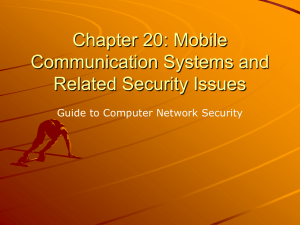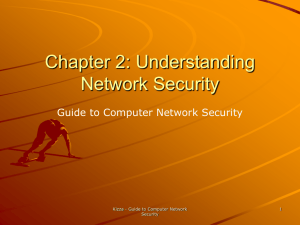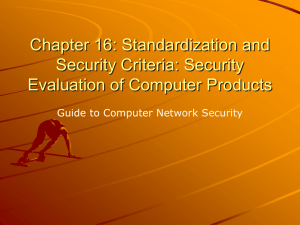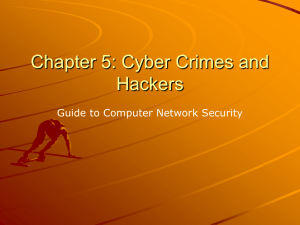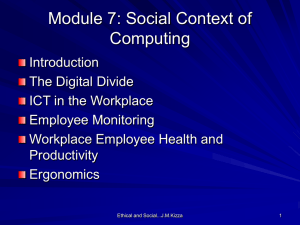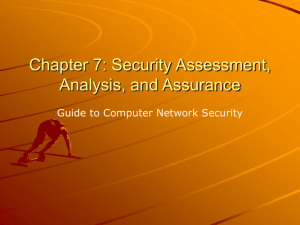Chapter 3
advertisement
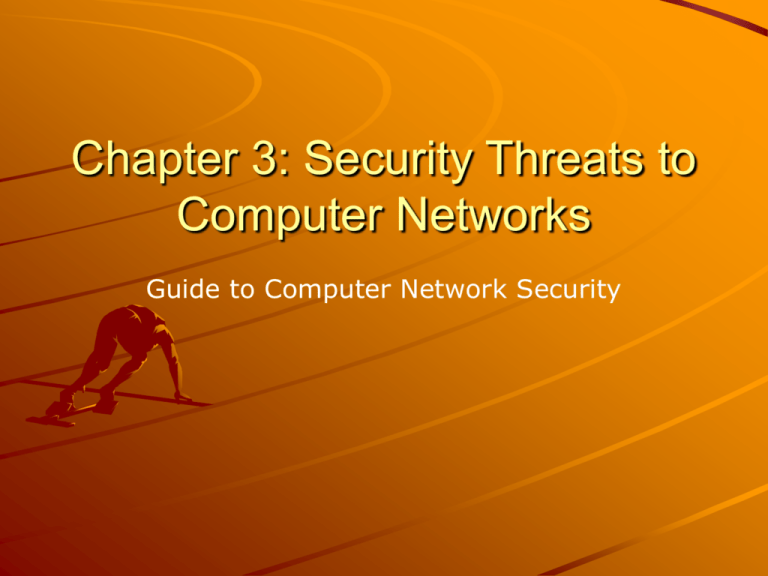
Chapter 3: Security Threats to Computer Networks Guide to Computer Network Security Status of Computer Networks In February, 2002, the Internet security watch group CERT Coordination Center disclosed that global networks including the Internet, phone systems, and the electrical power grid are vulnerable to attack because of weakness in programming in a small but key network component. The component, an Abstract Syntax Notation One, or ASN.1, is a communication protocol used widely in the Simple Network Management Protocol (SNMP). Kizza - Guide to Computer Network Security 2 This is one example of what is happening and will continue to happen. The number of threats is rising daily, yet the time window to deal with them is rapidly shrinking. Hacker tools are becoming more sophisticated and powerful. Currently the average time between the point at which a vulnerability is announced and when it is actually deployed in the wild is getting shorter and shorter. Kizza - Guide to Computer Network Security 3 Sources of Security Threats Design Philosophy – “Work in progress” - the philosophy was not based on clear blueprints, new developments and additions came about as reactions to the shortfalls and changing needs of a developing infrastructure. The lack of a comprehensive blueprint and the demand-driven design and development of protocols are causing the ever present weak points and loopholes in the underlying computer network infrastructure and protocols. – In addition to the philosophy, the developers of the network infrastructure and protocols also followed a policy to create an interface that is as user-friendly, efficient, and transparent as possible so that all users of all education levels can use it unaware of the working of the networks, and therefore, are not concerned with the details. 4 Kizza - Guide to Computer Network Security – Making the interface this easy and far removed from the Weaknesses in Network Infrastructure and Communication Protocols – The Internet is a packet network that works by breaking data, to be transmitted into small individually addressed packets that are downloaded on the network’s mesh of switching elements. Each individual packet finds its way through the network with no predetermined route and the packets are reassembled to form the original message by the receiving element. – To work successfully, packet networks Kizza - Guide to Computer Network Security 5 – As packets are di-assembled, transmitted, and re-assembled, the security of each individual packet and the intermediary transmitting elements must be guaranteed. This is not always the case in the current protocols of cyberspace. There are areas where, through port scans, determined users have managed to intrude, penetrate, fool, and intercept the packets. – The cardinal rule of a secure communication protocol in a server is never to leave any port open in the absence of a useful service. If no such service is offered, its port should never be open – In the initial communication between a client and a server, the client addresses the server via a port number inKizza a -process called a three-way 6 Guide to Computer Network Security handshake. – The process begins by a client/host sending a TCP segment with the synchronize (SYN) flag set, the server/host responds with a segment that has the acknowledge valid (ACK) and SYN flags set, and the first host responds with a segment that has only the ACK flag set. This exchange is shown in Figure 3.1. The three-way handshake suffers from a half-open socket problem when the server trusts the client that originated the handshake and leaves its port door open for further communication from the client. – As long as the half-open port remains open, an intruder can enter the system because while one port remains open, the server can still entertain other three-way handshakes from other clients 7 Kizza - Guide to Computer Network that want to communicate with it. Security Rapid Growth of Cyberspace – – There is always a security problem in numbers. – At a reported current annual growth rate of 51% over the past 2 years, this shows continued strong exponential growth, with an estimated growth of up to 1 billion hosts in a few years, if the same growth rate is sustained. – As more and more people join the Internet, more and more people with dubious motives are also drawn to the Internet. – Statistics from the security company Symantec show that Internet attack activity is currently growing by about 64% per year. The same statistics show that during the first 6 months of 2002, companies connected to the Internet were attacked, on average, 32 times per week compared to only 25 times per week in the last 6 8 Kizza - Guide to Computer Network months of 2001. Security The Growth of the Hacker Community – the number one contributor to the security threat of computer and telecommunication networks more than anything else is the growth of the hacker community. – Hackers have managed to bring this threat into news headlines and people’s living rooms through the ever increasing and sometimes devastating attacks on computer and telecommunication systems using viruses, worms, and distributed denial of services. The Big “Bungs” (1988 through 2003): Kizza - Guide to Computer Network Security 9 The Internet Worm - On November 2, 1988 Robert T. Morris, Jr., a Computer Science graduate student at Cornell University, using a computer at MIT, released what he thought was a benign experimental, selfreplicating, and self-propagating program on the MIT computer network. Michelangelo Virus - 1991. The virus affected only PCs running MS-DOS 2.xx and higher. Although it overwhelmingly affected PCs running DOS operating systems, it also affected PCs running other operating systems such as UNIX, OS/2, and Novell Melissa Virus -1999 It affected the global network of computers via a combination of Microsoft's Outlook and Word programs, takes advantage of Word documents to act as surrogates and the users' e-mail address book entries to propagate it. The Y2K Bug The Goodtimes E-mail Virus - was a humorous and a chain e-mail virus annoying every one in its path - Guide to Computer Network because of the Kizza huge amount of “email virus alerts” it 10 Security generated. Its humor was embedded in prose. Distributed Denial-of-Service (DDoS) – 2000. Was created by a 16-year-old Canadian hacker nicknamed “Mafiaboy” Using the Internet’s infrastructure weaknesses and tools he unleashed a barrage of remotely coordinated blitz of 1-gigabits-per-second IP packet requests from selected, sometimes unsuspecting victim servers which , in a coordinated fashion, bombarded and flooded and eventually overcame and knocked out servers at Yahoo eBay, Amazon, Buy.com, ZDNet, CNN, E*Trade, and MSN. Love Bug Virus - 2000- By Onel de Guzman, a dropout from a computer college in Manila, The Philippines. Anna Kournikova virus – 2001 – named after Anna Kournikova, the Russian tennis star. Hit global computer networks hard. 11 Kizza - Guide to Computer Network Security Vulnerability in Operating System Protocol – This an area that offers the greatest security threat to global computer systems – An operating system plays a vital role not only in the smooth running of the computer system in controlling and providing vital services, but it also plays a crucial role in the security of the system in providing access to vital system resources. – A vulnerable operating system can allow an attacker to take over a computer system and do anything that any authorized super user can do, such as Kizza - Guide to Computer Network Security 12 The Invisible Security Threat -The Insider Effect – Research data from many reputable agencies consistently show that the greatest threat to security in any enterprise is the guy down the hall. Social Engineering – – An array of methods an intruder such as a hacker, both from within or outside the organization, uses to gain system authorization through masquerading as an authorized user of the network. Social engineering can be carried out using a variety of methods, including physically Kizza - Guide to Computer Network Security 13 Physical Theft – As the demand for information by businesses to stay competitive and nations to remain strong heats up, laptop computer and PDA theft is on the rise. – There is a whole list of incidents involving laptop computer theft such as the reported disappearance of a laptop used to log incidents of covert nuclear proliferation from a sixth-floor room in the headquarters of the U.S. State Department in January, 2000. In March of the same year, a British accountant working for the MI5, a British national spy agency, had his laptop computer snatched from between his legs while waiting for a train at London's Paddington Station. – And according to the computer-insurance firm Safeware, some 319,000 laptops were stolen in 1999, at a total cost of more than $800 million for the hardware [7]. Thousands of 14 Kizza -alone Guide to Computer Network Security company executive laptops and PDA disappear Security Threat Motives Terrorism - – Our increasing dependence on computers and computer communication has opened up the can of worms, we now know as electronic terrorism. – Electronic terrorism is used to attack military installations, banking, and many other targets of interest based on politics, religion, and probably hate. – Those who are using this new brand of terrorism are a new breed of hackers, who no longer hold the view of cracking systems as an intellectual exercise but as a way of gaining from the action. – The “new” hacker is a cracker who knows and is aware of the value ofto information that he/she is15 Kizza - Guide Computer Network Security trying to obtain or compromise. But cyber- Military Espionage For generations countries have been competing for supremacy of one form or another. During the Cold War, countries competed for military spheres. After it ended, the espionage turf changed from military aim to gaining access to highly classified commercial information that would not only let them know what other countries are doing but also might give them either a military or commercial advantage without their spending a great deal of money on the effort.. Our high dependency on computers in the national military and commercial establishments has given espionage a new fertile ground. Electronic espionage has many advantages Kizza - Guide to Computer Network Security 16 Economic Espionage – The end of the Cold War was supposed to bring to an end spirited and intensive military espionage. However, in the wake of the end of the Cold War, the United States, as a leading military, economic, and information superpower, found itself a constant target of another kind of espionage, economic espionage. – In its pure form, economic espionage targets economic trade secrets which, according to the 1996 U.S. Economic Espionage Act, are defined as all forms and types of financial, business, scientific, technical, economic, or engineering information and all types of intellectual property including patterns, plans, compilations, program devices, formulas, designs, prototypes, methods, techniques, processes, procedures, programs, and/or codes, whether tangible or not, stored or17 Kizza - Guide to Computer Network not, compiled or not.Security Targeting the National Information Infrastructure – The threat may be foreign powersponsored or foreign power-coordinated directed at a target country, corporation, establishments, or persons. – It may target specific facilities, personnel, information, or computer, cable, satellite, or telecommunications systems that are associated with the National Information Infrastructure. Kizza - Guide to Computer Network Security 18 – Activities may include: Denial or disruption of computer, cable, satellite, or telecommunications services; Unauthorized monitoring of computer, cable, satellite, or telecommunications systems; Unauthorized disclosure of proprietary or classified information stored within or communicated through computer, cable, satellite, or telecommunications systems; Unauthorized modification or destruction of computer programming codes, computer network databases, stored information or computer capabilities; or Manipulation of computer, cable, satellite, or telecommunications services resulting in Kizza - Guide to Computer Network fraud, financial loss, or other federal criminal19 Security Vendetta/Revenge Hate (National Origin, Gender, and Race) Notoriety Greed Ignorance Kizza - Guide to Computer Network Security 20 Security Threat Management Security threat management is a technique used to monitor an organization’s critical security systems in real-time to review reports from the monitoring sensors such as the intrusion detection systems, firewall, and other scanning sensors. These reviews help to reduce false positives from the sensors, develop quick response techniques for threat containment and assessment, correlate and escalate false positives across multiple sensors or platforms, and develop intuitive analytical, Kizza - Guide to Computer Network Security 21 Risk Assessment – Even if there are several security threats all targeting the same resource, each threat will cause a different risk and each will need a different risk assessment. – Some will have low risk while others will have the opposite. It is important for the response team to study the risks as sensor data come in and decide which threat to deal with first. Forensic Analysis – Forensic analysis is done after a threat has been identified and contained. After containment the response team can launch the forensic analysis tools to interact with the dynamic report displays that have come from the sensors during the duration of the threat or attack, if the threat results in an attack. – The data on which forensic analysis is to be put must be kept in a secure state to preserve the evidence. It must be stored and transferred, if this is needed, with the greatest care, and the analysis must be done with the utmost professionalism possible if the results of the forensic 22 Kizza - Guide to Computer Network analysis are to stand in court. Security Security Threat Awareness Security threat awareness is meant to bring widespread and massive attention of the population to the security threat. Once people come to know of the threat, it is hoped that they will become more careful, more alert, and more responsible in what they do. They are also more likely to follow security guidelines. A good example of how massive awareness can be planned and brought about is the efforts of the new U.S. Department of Homeland Security. The department was formed after the September 11, 2001 attack on the United States to bring maximum national awareness to the security problems facing not only the country but also every individual. The idea is to make everyone proactive to security. Figure 3.5 shows some of the efforts of the Department of Homeland Security for massive security awareness. Kizza - Guide to Computer Network Security 23
